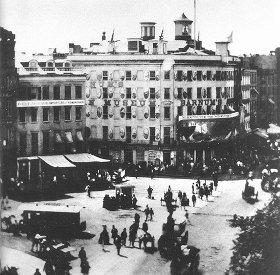
P.T. Barnum conceived a novel way to advertise his American Museum: He paid a man to place a brick at each of five New York intersections and to spend the day marching industriously from one to the next, exchanging bricks at each stop.
“What is the object of this?” inquired the man.
“No matter,” said Barnum. “All you need to know is that it brings you fifteen cents wages per hour. It is a bit of my fun, and to assist me properly you must seem to be as deaf as a post; wear a serious countenance; answer no questions; pay no attention to anyone; but attend faithfully to the work, and at the end of every hour, by St. Paul’s clock, show this ticket at the Museum door; enter, walking solemnly through every hall in the building; pass out, and resume your work.”
Within an hour the sidewalks were packed, and many spectators bought tickets so they could follow the mysterious man inside. “This was continued for several days — the curious people who followed the man into the Museum considerably more than paying his wages — till, finally, the policeman, to whom I had imparted my object, complained that the obstruction of the sidewalk by crowds had become so serious that I must call in my ‘brick man.'”
“This trivial incident excited considerable talk and amusement; it advertised me; and it materially advanced my purpose of making a lively corner near the Museum.”



